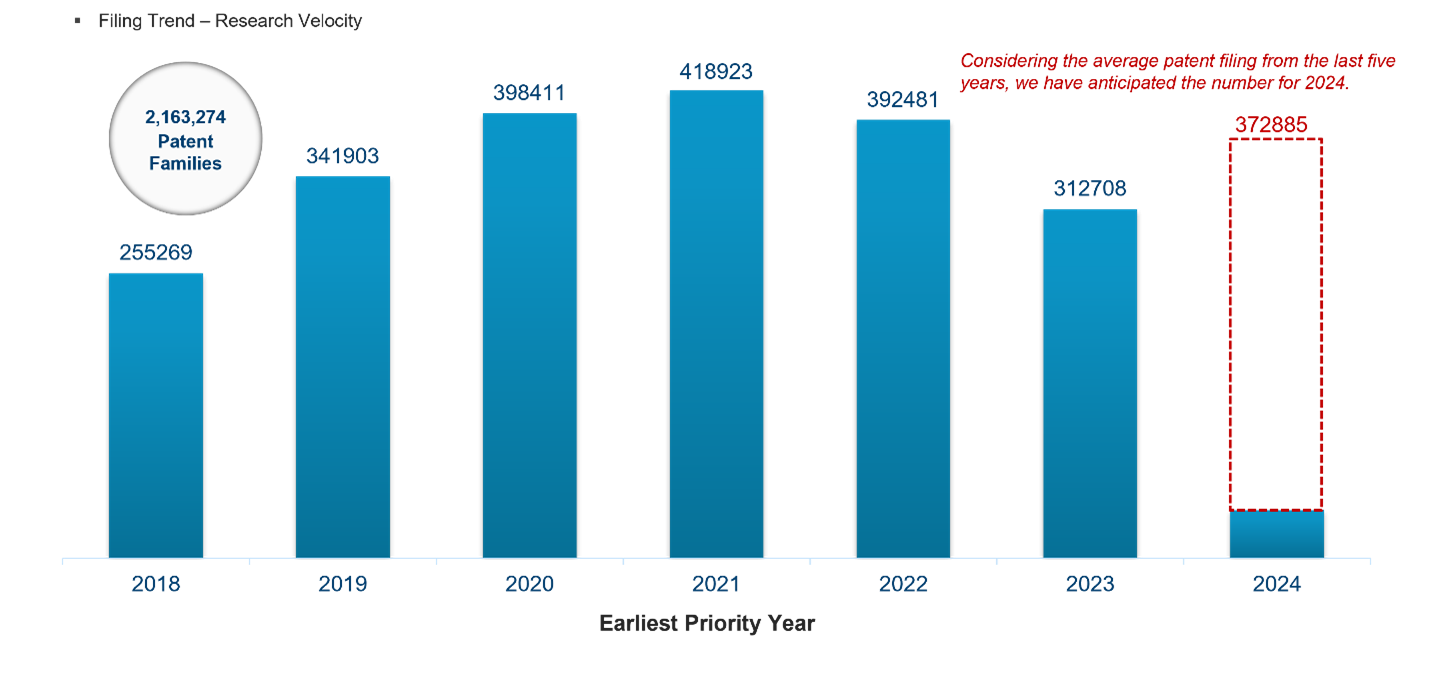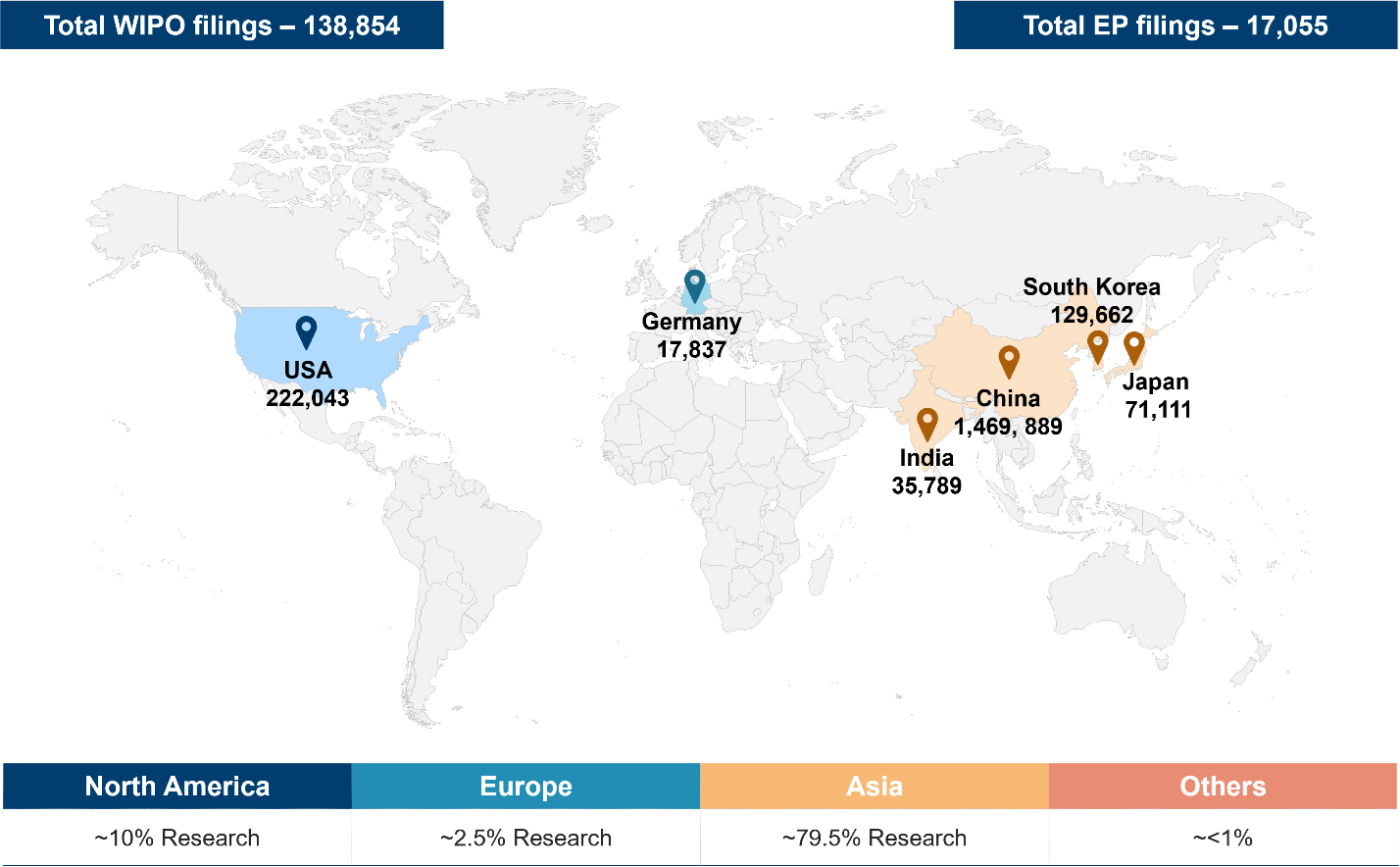AI Patent Race Among Global Leaders
Published on 21 Aug, 2024

Artificial Intelligence (AI) is reshaping industries and revolutionizing the global economy. The surge in AI-related patents is a testament to its growing influence, with countries like South Korea, Japan, India, and Germany stepping into the spotlight. These nations are strategically leveraging AI to accelerate digital transformation, enhance industrial automation, and optimize business operations. Meanwhile, China and the United States fiercely lead the global AI patent race, propelled by significant contributions from academia and industry. This competitive patent landscape highlights AI’s role in driving future economic growth and innovation, cementing its place as a cornerstone of any forward-thinking strategy.
Artificial Intelligence (AI) is no longer a futuristic concept but a tangible reality rapidly transforming industries worldwide. Its exponential growth and development have made it an indispensable tool for businesses seeking to optimize operations, enhance decision-making, and gain a competitive edge. From healthcare to finance, manufacturing to retail, AI's influence is pervasive, and its adoption is inevitable.
The patent landscape offers a unique lens into the pace and direction of AI. The surge in AI-related patents is a clear indicator of the intense competition among businesses to secure intellectual property rights (IPR) for their innovations. From complex algorithms application to hardware advancements, the patent ecosystem shows the evolution of AI capabilities.

The top countries driving AI patent research exhibit significant disparities in patent filings. China, the United States, South Korea, India, Japan, and several European countries are at the forefront of the AI patent race. China has emerged as a dominant player due to substantial government investments and a focus on domestic AI development. The United States, a pioneer in technology, continues to hold a strong position driven by research collaboration and private sector investment. South Korea, India, Japan, and Germany have also made strides, with government support, industry involvement, and a strategic focus on AI applications driving their patent filings.

While all these nations aim for AI leadership, their approaches and strengths vary. To better understand the competitive landscape, we will examine key differentiators from patents perspective:

These top countries are extensively researching computer vision AI, particularly through convolutional neural networks (CNNs), to unlock its vast potential across various sectors. This focus on CNNs is driven by their ability to enhance image recognition, object detection, and visual data processing, making them a foundation of AI-driven innovation. As these nations delve deeper into CNNs, they simultaneously apply these AI techniques to computing technology, where software optimization, algorithm refinement, and data management become crucial. The synergy between advancements in computer vision and their application in computing reflects a holistic approach to AI, demonstrating how these innovations are interconnected in driving technological progress and shaping the future of industries.
Primary driving forces of AI research:
The AI patent landscape is shaped by corporate entities, with approximately 76% of patents originating from private companies. This dominance underscores the commercial focus of AI research and development, as corporations seek to gain a competitive edge through intellectual property protection. Tech giants with substantial financial resources and research capabilities are at the forefront of this trend, investing heavily in AI to drive innovation and market share.

However, universities and research institutions continue to play a pivotal role in the AI ecosystem. Contributing approximately 24% of AI patents, these academic institutions serve as incubators for groundbreaking research, often laying the foundation for future commercial applications. Collaborations between industry and academia are increasingly common, fostering the transfer of knowledge transfer and accelerating the pace of AI innovation.
China: The Undisputed Leader
China has emerged as the global frontrunner in AI patent filings, solidifying its position as a dominant force in the industry. This surge in patent activity underscores the nation's strategic focus on AI as a key driver of economic growth and technological advancement. Chinese tech giants like Tencent, State Grid, Huawei, and Baidu have been instrumental in driving China’s patent surge, with emphasis on computer vision, natural language processing, and automation.

The United States: A Persistent Innovator
China leads in sheer volume of AI patents, while the U.S. stands out for its innovation, with major contributors like IBM, Microsoft, Intel, and Google advancing the field. U.S. universities, including MIT, Stanford, and University of California also play a crucial role in AI breakthroughs. For instance, Stanford's patent (US10859657B2) enhances MRI technology by utilizing deep neural networks to boost imaging speed and precision, which is vital for diagnostics. Similarly, the University of California's patent (US20230401447A1) progresses optical computing with a system that employs light for real-time image analysis, benefiting medical imaging and security. These examples demonstrate the high caliber of U.S. research, as reflected in their highly cited patents, despite their low rank in patent filings. The 55% grant ratio highlights the U.S.'s leadership in research quality, supported by both academic and corporate contributions.

South Korea, Japan, India, and Germany: Regional Powerhouses
South Korea, Japan, India, and Germany have established themselves as key players in the global AI patent race. South Korea's focus on technology and innovation, coupled with the support of the government, has propelled its AI industry forward. This is driven by companies like Samsung and LG, and universities, such as Seoul National University and Korea Advanced Institute of Science & Technology, which are actively involved in AI research and development. Japan, with its strong robotics and electronics industry, has a solid foundation in AI. Companies such as Toyota and Canon are making significant strides in AI-related patents. In India, private universities such as Lovely Professional University and Chandigarh University, and key companies like Tata Consultancy Services are driving much of the research. Germany, known for its engineering prowess, is focusing on the industrial applications of AI. Bosch and Siemens are also leading the charge in this domain.
The global race for AI patent dominance shows the extraordinary pace of technological advancements and the strategic significance of AI in shaping the future of industries and economies. As tech giants across the globe compete for leadership, their relentless drive for innovation highlights how critical AI is in transforming various sectors. To build a strong AI ecosystem that can sustain this momentum, a concerted effort is required—one that involves not only substantial government support and private investment but also a commitment to open innovation. Central to this effort is the need for enhanced collaboration between academia and industry, particularly in high-impact areas such as healthcare, robotics, manufacturing, and computing. These partnerships are essential for accelerating breakthroughs and ensuring that AI delivers meaningful benefits across multiple domains. In our upcoming article, we explore these key research areas, innovative AI techniques, and the collaborative efforts of leading companies, offering insights into how the future of AI is shaped. Stay tuned for a comprehensive look at this dynamic field and what lies ahead!


